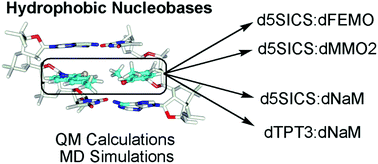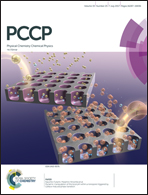How do hydrophobic nucleobases differ from natural DNA nucleobases? Comparison of structural features and duplex properties from QM calculations and MD simulations†
Abstract
Computational (DFT and MD simulation) methods are employed to systematically characterize the structural and energetic properties of five hydrophobic nucleobases (FEMO, MMO2, NaM, 5SICS and TPT3) that constitute four unnatural base pairs (FEMO:5SICS, MMO2:5SICS, NaM:5SICS and TPT3:NaM). These hydrophobic bases have been recently shown to be replicated when present between natural bases in DNA duplexes, with the highest replication fidelity and efficiency occuring for the TPT3:NaM pair. Our QM calculations suggest that the preferred (anti) glycosidic orientations of nucleosides containing hydrophobic bases are similar to the natural DNA nucleosides despite differences in their chemical structures. However, due to the inability to form interbase hydrogen bonds, hydrophobic base pairs intrinsically prefer nonplanar, distorted geometries, many of which are stabilized through π–π stacking interactions. Furthermore, the intrinsic stacking potential between a hydrophobic and a natural base is similar to that between two natural bases, indicating that the strength of stacking interactions in DNA duplexes containing hydrophobic bases is likely comparable to natural DNA. However, in contrast to the isolated base-pair geometries, our MD simulations suggest that the hydrophobic base pairs adopt variable geometries within DNA, which range from stacked (5SICS:FEMO) to nearly planar (5SICS:NaM and SICS:MMO2) to planar (TPT3:NaM). As a result, the duplex structural features at the site of modification depend on the identity of the hydrophobic base pair, where the TPT3:NaM pair causes the least structural changes compared to natural DNA. Overall, the structural insight obtained from our calculations on DNA containing hydrophobic base pairs explains the experimentally-observed higher fidelity and efficiency during replication of TPT3:NaM compared to other hydrophobic nucleobase pairs. By providing valuable structural information that explains the intrinsic and duplex properties of this class of unnatural nucleobases, the present work may aid the future design of improved hydrophobic analogues.

- This article is part of the themed collection: 2017 PCCP HOT Articles


 Please wait while we load your content...
Please wait while we load your content...